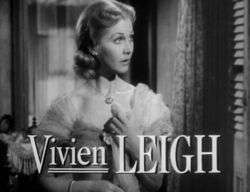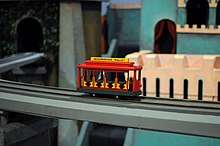Trams in popular culture
There are many references to trams in popular culture. Major references include:
Drama

Vivien Leigh in the trailer for the 1951 film, A Streetcar Named Desire.
- A Streetcar Named Desire was written by Tennessee Williams in 1947. The same play was also made into multiple films (see below), and a ballet in 1993 (see "Ballet" section).
Film
- Alfred Hitchcock was a well-known rail enthusiast with a particular interest in London trams. An overwhelming majority of his films include rail or tram scenes, in particular The Lady Vanishes, Strangers on a Train and Number Seventeen.[1]
- There have been three film versions of A Streetcar Named Desire: in 1951, in 1984 and in 1995
- Black Orpheus (1959), has a lead character, Orfeu, who is a tram driver on Rio de Janeiro's tram system.
- The central plot of the film Who Framed Roger Rabbit involves Judge Doom, the villain, dismantling the streetcars of Los Angeles.
- Malcolm, is an Australian film about a tram enthusiast who uses his inventions to pull off a bank heist. There are many scenes of Melbourne trams, as well as models of Melbourne and Adelaide trams, and (at the end of the film) scenes showing Lisbon trams.
- Luis Buñuel filmed La Ilusión viaja en tranvía[2] (English: Illusion Travels by Streetcar) in Mexico in 1953.
- In Akira Kurosawa's film Dodesukaden a mentally ill boy pretends to be a tram conductor.
- Tramvaj (Tram) is an eight-minute, 2012 Czech short animated film directed by Michaela Pavlátová.
- The Herbie films are a series about a Volkswagen named Herbie. The second film, Herbie Rides Again, has tram 27 living in the garden, near to Herbie. 27 plays a major part in the plot of the film.
Literature
- One of the earliest literary references to trams occurs on the second page of Henry James's novel The Europeans:
From time to time a strange vehicle drew near to the place where they stood—such a vehicle as the lady at the window, in spite of a considerable acquaintance with human inventions, had never seen before: a huge, low, omnibus, painted in brilliant colours, and decorated apparently with jingling bells, attached to a species of groove in the pavement, through which it was dragged, with a great deal of rumbling, bouncing, and scratching, by a couple of remarkably small horses.— Henry James, The Europeans, Page 2
- Published in 1878, the novel is set in the 1840s, though horse trams were not introduced in Boston till the 1850s. Note how the tram's efficiency surprises the European visitor; how two "remarkably small" horses sufficed to draw the "huge" tramcar.
- Joseph Conrad described Amsterdam's trams in chapter 14 of The Mirror of the Sea (1906): "From afar at the end of Tsar Peter Straat, issued in the frosty air the tinkle of bells of the horse tramcars, appearing and disappearing in the opening between the buildings, like little toy carriages harnessed with toy horses and played with by people that appeared no bigger than children."
- In episode 6 ("Hades") of James Joyce's Ulysses (1918), the party on the way to Paddy Dignam's funeral in a horse-drawn carriage idly debates the merits of various tramway improvements:
I can't make out why the corporation doesn't run a tramline from the parkgate to the quays, Mr Bloom said. All those animals could be taken in trucks down to the boats.
Instead of blocking up the thoroughfare, Martin Cunningham said. Quite so. They ought to.
Yes, Mr Bloom said, and another thing I often thought is to have municipal funeral trams like they have in Milan, you know. Run the line out to the cemetery gates and have special trams, hearse and carriage and all. Don't you see what I mean?
- – O that be damned for a story, Mr Dedalus said. Pullman car and saloon diningroom.
- – A poor lookout for Corny [the undertaker], Mr Power added.
- – Why? Mr Bloom asked, turning to Mr Dedalus. Wouldn't it be more decent than galloping two abreast?[3]
— The party on the way to Paddy Dignam's funeral, in James Joyce, Ulysses, Episode 6 ("Hades")
- The Moscow tramway figures prominently at the beginning of Mikhail Bulgakov's novel The Master and Margarita, which was written between 1928 and 1940. In chapter 1 Satan/Professor Woland announces that Berlioz will die that evening because Anna has spilt sunflower oil, and indeed at the end of chapter 3 Berlioz slips on the tramway tracks and is decapitated.[4]
- Danzig trams figure extensively in the early stages of Günter Grass's Die Blechtrommel (The Tin Drum). In the last chapter the novel's hero Oskar Matzerath and his friend Gottfried von Vittlar steal a tram late at night from outside Unterrath depot on the northern edge of Düsseldorf. In a surreal journey, von Vittlar drives the tram through the night, south to Flingern and Haniel and then east to the suburb of Gerresheim.[5]
- In his 1967 spy thriller An Expensive Place to Die, Len Deighton misidentifies the Flemish coast tram: "The red glow of Ostend is nearer now and yellow trains rattle alongside the motor road and over the bridge by the Royal Yacht Club..."[6][7]
- The Rev W. Awdry wrote about GER Class C53 called Toby the Tram Engine, which starred in his The Railway Series with his faithful coach, Henrietta.
- In Haruki Murakami's novel Norwegian Wood, protagonist Toru Watanabe takes Tokyo's only surviving tramline, the Toden Arakawa Line, to near Ōtsuka Station: "I sat in the last seat and watched the ancient houses passing close to the window. The tram almost touched the overhanging eaves.... The tram snaked its way through this private back-alley world." [8]
Music

Judy Garland and the chorus performing The Trolley Song, a song inspired by a picture of a tram in a turn-of-the-century newspaper.
- "The Trolley Song" in the film Meet Me in St. Louis received an Academy Award nomination.
- In 2009 Thomas Haggerty composed and produced 'Tram' generations 1, 2 and 3 for the Slowcore/Indie Rock group, Tram.
Television

The Neighbourhood Trolley. a model tram that is commonly featured on Mister Rogers' Neighborhood.
- The US children's TV show Mister Rogers' Neighborhood features a trolley (tram). It is shown on National Educational Television, PBS, Sprout and the Canadian Broadcasting Corporation.
- Trams feature in the opening titles of the world's longest running TV soap opera Coronation Street, set in a fictional suburb of Greater Manchester, and produced by Granada Television. A Blackpool tram killed one of the main characters in 1989 and the most recent faked accident involved a tram (modelled on the Manchester Metrolink) careering off a viaduct into the set in 2009.
- A derelict Miskolc tram features as the plaything of a gang of children in the 1975 cult Hungarian television series Utánam, srácok! (After me, guys!).
Visual arts
- Tramway is a contemporary visual and performing arts venue located in the Scottish city of Glasgow. Based in the former Coplawill Glasgow Corporation Tramways depot in the Pollokshields area of the South Side, it consists of two performance spaces and two galleries, as well as offering facilities for community and artistic projects. It is claimed to be one of the leading venues of its type in Europe.[9]
- A major feature of Spencer Street railway station, Melbourne from 1978 to 2005 was the giant Cavalcade of Transport mural, measuring 7 by 38 metres (23 by 125 ft). It was financed by the Victorian state government, and painted by Harold Freedman. It features all forms of transport used in Victoria from 1835 to 1978, with trams featuring prominently. A horizontal column of trams shows the progression of vehicle design, with some dozens of trams being illustrated. In 2000, during a revamp and renaming of the station to Southern Cross railway station, part of the mural was removed. It was taken down completely in 2005 and, after a cleaning, was in 2007 relocated to Spencer Outlet Centre, adjoining the railway station.[10]
- A sculpture of tram 1040, the last numbered of Melbourne's iconic "W"-class trams was unveiled at the corner of Flinders and Spencer Streets, Melbourne, in October 2013. The sculpture is the work of local artist David Ball.[11] It can be viewed from a number of tram routes, and is just one block from Southern Cross railway station.[12]
Ballet
- The drama, A Streetcar Named Desire was the basis of a 1993 ballet.
Opera
- In 1995, an opera derived from the drama A Streetcar Named Desire was first produced.
Other
- Toonerville Folks comic strip (1908–55) by Fontaine Fox featured the "Toonerville Trolley that met all the trains".
- The predominance of trams (trolleys) in the borough of Brooklyn in New York City gave rise to the disparaging term trolley dodger for residents of the borough. That term, shortened to "Dodger" became the nickname for the Brooklyn Dodgers (now the Los Angeles Dodgers).
- A representation of a Melbourne W-type tram featured at the opening ceremony of the 2006 Commonwealth Games in Melbourne. A model of the "flying tram" (as it was dubbed) is now exhibited at the Melbourne Museum.[13]
- Tramway, North Carolina, is an area of Lee County, North Carolina which politically forms part of Sanford.
References
- Patrick McGilligan, 2003. Buckley, R. J. 1984. Alfred Hitchcock: A Life in Darkness and Light (ISBN 0-470-86973-9). Chichester, UK, John Wiley & Sons Ltd.
- Illusion Travels by Streetcar on IMDb
- pp. 94–5 of Penguin edition
- https://www.weblitera.com/book/?id=205&lng=1&ch=1&l=
- The chapter Die letzte Straßenbahn oder Anbetung eines Weckglases (The last tram or Adoration of a Preserving Jar). See page 584 of the 1959 Büchergilde Gutenberg German edition and page 571 of the 1961 Secker & Warburg edition, translated into English by Ralph Manheim
- "Ryco : welkom". Ryco.be. Archived from the original on 6 November 2015. Retrieved 8 March 2015.
- Chapter 38, p. 198 of the Companion Book Club edition
- p. 84, Vintage Books edition.
- "Glasgow Museums". glasgowmuseums.com. Archived from the original on 20 January 2008.
- "Southern Cross 'Cavalcade of Transport' mural takes back door to shopping centre progress". The Age. Archived from the original on 16 October 2015.
- "David Ball : Resume" (PDF). Davidmitchelbell.com. Archived (PDF) from the original on 16 April 2015. Retrieved 8 March 2015.
- "Iconic W-class tram up-ended at Melbourne intersection – in the name of art". Heraldsun.com.au. Retrieved 2015-03-08.
- "Model - Flying Tram, Melbourne Commonwealth Games, 2005". Retrieved 2 May 2019.
This article is issued from Wikipedia. The text is licensed under Creative Commons - Attribution - Sharealike. Additional terms may apply for the media files.